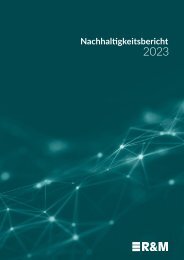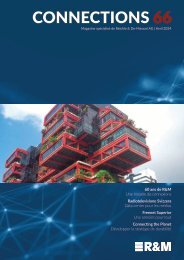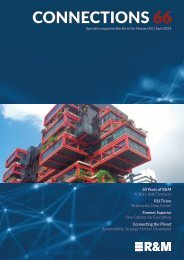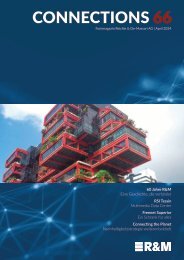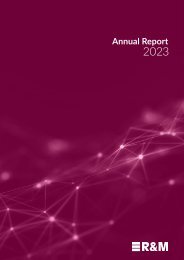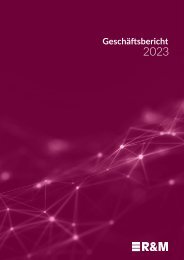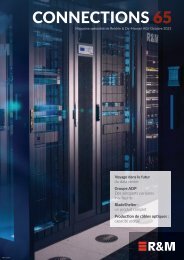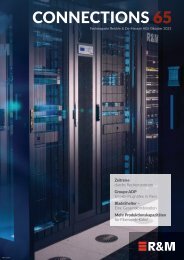CONNECTIONS_55-e
R&M customer magazine, Connectivity, Cabling, Fiber Optica, Copper
R&M customer magazine, Connectivity, Cabling, Fiber Optica, Copper
Create successful ePaper yourself
Turn your PDF publications into a flip-book with our unique Google optimized e-Paper software.
Focus<br />
Cabling evolution<br />
Structured cabling has proven itself over<br />
decades in local networks (LANs) on the IT<br />
and documentation side and so far has been<br />
implemented billions of times. Ethernet/IP<br />
turned out to be the perfect, omnipresent<br />
solution. To date such cabling has primarily<br />
been used for connecting computer workstations<br />
and for LAN applications.<br />
Now, further innovations are increasing the<br />
possible uses of IP/Ethernet. For example,<br />
Power over Ethernet (PoE), launched 15 years<br />
ago. Originally it was mainly used to operate<br />
VoIP telephones, IP cameras, monitors and<br />
smaller end devices in office environments.<br />
But it can also be used for the simple connection<br />
of devices and sensors in the building<br />
automation system. With a suitable cabling<br />
structure, the LAN could thus become the<br />
backbone for the entire building automation<br />
system as soon as the latter communicates<br />
over Ethernet/IP.<br />
«Digital Ceiling» is the latest cabling concept<br />
for building automation for which R&M already<br />
has a holistic installation solution. This<br />
involves having an appropriate number of<br />
service outlets pre-installed on room ceilings<br />
at regular intervals. WLAN access points,<br />
LED lamps, building technology modules and<br />
distributed network switches can be installed<br />
in a flash whenever required at these service<br />
outlets. Using this kind of structured building<br />
automation cabling, the devices can not only<br />
be supplied with data but simultaneously with<br />
electricity using PoE feeding.<br />
Advantages of consolidation<br />
All over IP. The migration of building technology<br />
right down to the sensor/actuator level to Ethernet/IP<br />
in connection with Digital Ceiling, Power<br />
over Ethernet (PoE) and Single Pair Ethernet<br />
(SPE) offers a whole range of advantages:<br />
– open and manufacturer-independent digital<br />
systems<br />
– standardized cabling, interfaces, protocols<br />
– no special knowledge necessary for field<br />
bus systems<br />
– relatively low material, device, operating<br />
expenses<br />
– simple network installation and maintenance<br />
– space-saving, energy-saving infrastructures<br />
– central management of networkable<br />
components<br />
–comprehensive real-time analysis of building<br />
systems<br />
Equipping building automation systems with<br />
IP/Ethernet is still in its infancy. Now virtually<br />
every building automation function can be<br />
found in this setup. This development opens<br />
up as yet undreamed of application possibilities<br />
and must be seen as a major step on<br />
the road to smart buildings. With continuous,<br />
standardized networking on an IP basis, there<br />
are no more interface problems and the integration<br />
of all information in one standardized<br />
building master control system is simplified.<br />
Instead of half a dozen independent systems,<br />
in future it will only be necessary to maintain<br />
one system.<br />
When creating Digital Ceiling cabling, it must<br />
be ensured that it can cope with the expected<br />
current load. R&M provides calculation tools<br />
050.6458<br />
050.6663<br />
Structured LAN cabling (red) with Ethernet/<br />
IP data transmission has been used to connect<br />
workstations for decades.<br />
Power over Ethernet (green) came onto the<br />
scene in the last 15 years. It incorporates, for<br />
example, cameras and WLAN antennas into the<br />
LAN and at the same time supplies them with<br />
electricity.<br />
For a short while now, the structured LAN cabling<br />
has been able to integrate first building functions<br />
(blue) e.g. individual sensors and LED light<br />
sources. Digital Ceiling is the ideal way to expand<br />
the LAN cabling for this purpose.<br />
6 10I2018–<strong>55</strong> <strong>CONNECTIONS</strong>









